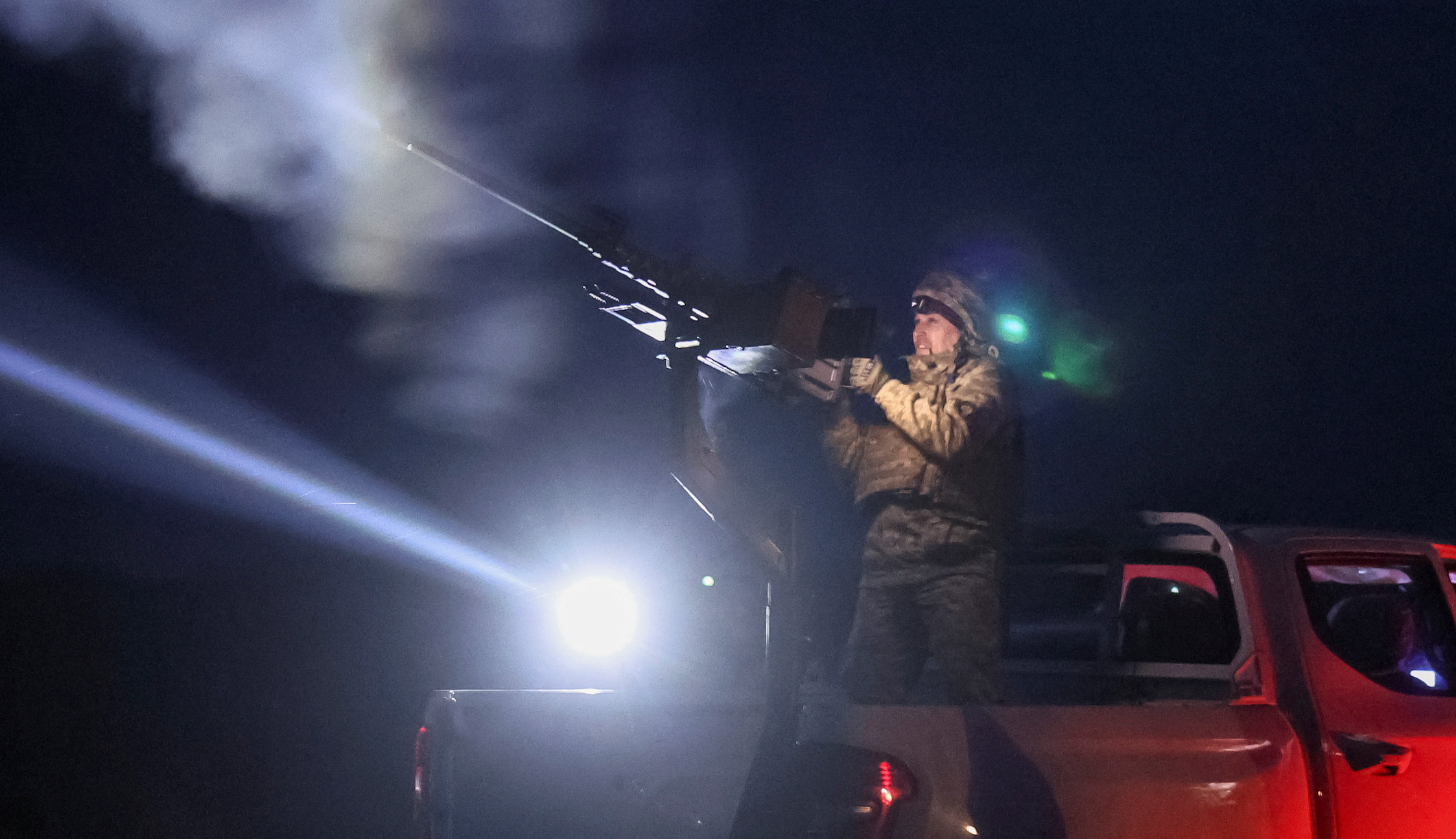
US aid will boost Ukraine, but doubts remain over 2025 supplies
PHOTO CAPTION: A Ukrainian serviceman from anti-drone mobile air defence unit fires a Browning machine gun at his position during combat, amid Russia's attack on Ukraine, in Chernihiv region, Ukraine March 28, 2024. REUTERS/Gleb Garanich
By Patricia Zengerle and Humeyra Pamuk
WASHINGTON (Reuters) - The Biden administration wants to start moving weapons and equipment into Ukraine within days of the anticipated passage this week of legislation that includes $60 billion in military aid to Kyiv, a long-delayed lifeline for the embattled nation.
The aid would arrive much later than Ukraine - running low on ammunition and staggering under a renewed Russian onslaught - had hoped, and analysts caution that there is no guarantee that more will be forthcoming.
But officials and experts agree that the artillery rounds, precision-guided missiles and air defenses will change the military outlook for Ukraine.
"With the boost that will come from military assistance, both practically and psychologically, the Ukrainians are entirely capable of holding their own through 2024 and puncturing Putin’s arrogant view that time is on his side," CIA Director William Burns said on Thursday at the Bush Center Forum on Leadership in Dallas.
Ammunition, interceptors for air defense systems and long-range weapons can begin moving "within days" once the bills become law, said a U.S. official.
"There won't be any delays or bottlenecks on the U.S. side," the official said.
More than two years into Russia's full-scale invasion, Ukraine has lost territory in the eastern part of the country and Russia has ramped up its bombardment of cities and towns behind the front lines amid a slowdown in Western military assistance.
Aid for Ukraine had been held up for months over objections from hard-right Republican lawmakers in the U.S. House of Representatives.
On Saturday, the House passed a $95 billion legislative package providing security assistance to Ukraine, Israel and Taiwan. It now heads to the Senate and passage is expected this week, clearing the way for President Joe Biden to sign it into law.
Over the weekend, Zelenskiy welcomed the advancing of the aid package in the House of Representatives, and repeatedly urged lawmakers to swiftly pass the bill in the Senate so the transfer of weapons can happen quickly.
The Biden administration is finalizing its next assistance package for Ukraine so it can announce the new tranche of aid soon after the bill becomes law to meet Ukraine’s urgent battlefield needs, a White House official said.
COSTLY DELAY
The delay in approving new supplies has been costly for Kyiv.
"The aid is coming way too late, as materiel shortages resulted in Ukraine losing the initiative in October 2023," said Kateryna Stepanenko, a Russia analyst at the Institute for the Study of War.
Since October, Ukraine has lost 583 square kilometers of territory to Russian forces, largely because of a lack of artillery, said Stepanenko, who added that Russia has had time to prepare for offensive operations expected in late spring or early summer.
But Ukraine's military should be able to put the munitions - especially ATACMS missiles, air defense interceptors and artillery shells - to use "almost immediately", said retired Vice Admiral Robert Murrett of the Institute for Security Policy and Law at Syracuse University.
Zelenskiy has asked for ATACMS, long-range guided missiles that allow Ukraine to hit targets such Russian command posts and weapons depots in Crimea.
Senate Intelligence Committee Chair Mark Warner told CBS' "Face the Nation" on Sunday that military equipment including the longer-range ATACMS should be "in transit by the end of the week" providing Senate also passes the legislation.
Ukraine should also receive more missiles for the Patriot air defense system, which has proven effective against missile and drone attacks.
Riki Ellison, founder of the Missile Defense Advocacy Alliance, said U.S. weapons makers had been ramping up production of missiles for the Patriot defense systems to meet demand and should be ready to ship missiles quickly.
POLITICAL UNCERTAINTY
Beyond 2024, however, uncertainties await Ukraine.
These include the possible reelection of former U.S. President Donald Trump, who has voiced skepticism over large amounts of Ukraine aid and has questioned how fast the U.S. and European defense industries can ramp up weapons production.
Trump won the Republican nomination in March and will face Biden, a Democrat, in the presidential election on Nov 5. The former president and hardline Republicans in Congress oppose further aid to Ukraine, with the possible exception of a loan.
"Ukraine needs to use 2024 to rebuild its force for the long war," said Max Bergmann, director of the Europe, Russia and Eurasia program at the Center for Strategic and International Studies in Washington.
"Europe’s goal should be to put itself in a position to potentially fill a future gap left by the United States should it not pass another supplemental," he said.
If signed into law the U.S. package could have a powerful signaling effect, not just in terms of Ukrainian morale but for other U.S. allies to contribute aid, said Jeffrey Pryce, international lawyer and senior fellow at the foreign policy institute at Johns Hopkins School of Advanced International Studies.
"If America goes first then other countries are much more comfortable adding to those supplies," Pryce said.
(This story has been refiled to add the full name and title of analyst Max Bergmann in paragraph 23)
(Reporting by Humeyra Pamuk, Patricia Zengerle, Raphael Satter, Idrees Ali, Andrea Shalal, Jonathan Landay, Steve Holland and Mike Stone; Writing by Humeyra Pamuk; Editing by Don Durfee)









